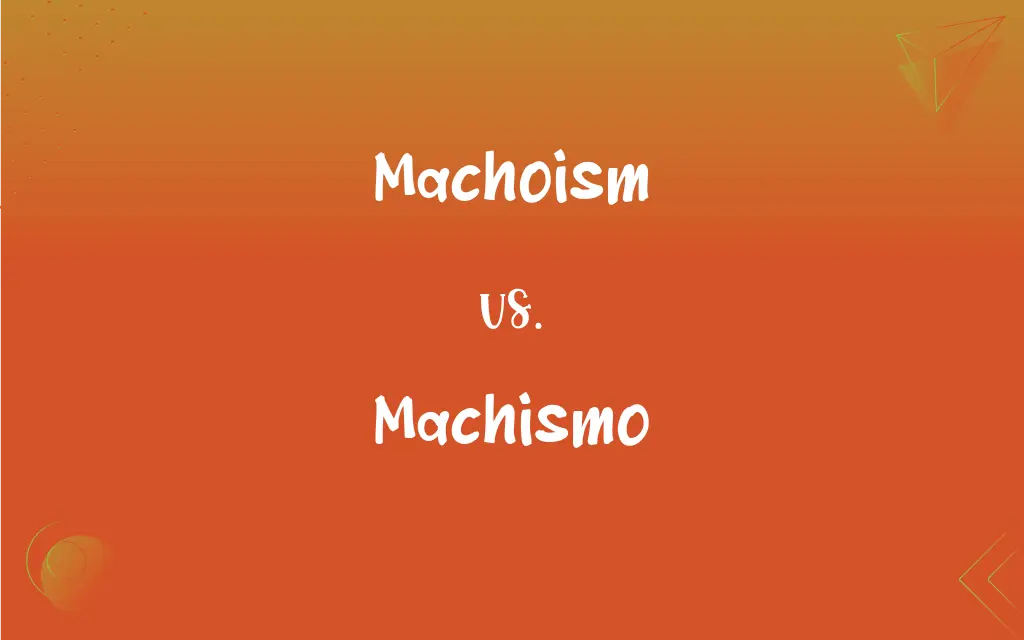Machoism vs. Machismo: What's the Difference?
By Aimie Carlson & Harlon Moss || Updated on May 21, 2024
Machoism refers to exaggerated masculinity and aggressive male behavior, while machismo denotes a strong or aggressive pride in masculinity, often culturally rooted.

Key Differences
Machoism is the display of exaggerated masculinity characterized by aggression and dominance. This behavior often manifests in an overly assertive manner, where men feel compelled to exhibit strength and control in various situations. Machismo, on the other hand, embodies a strong or aggressive pride in one's masculinity. It is deeply rooted in cultural contexts, particularly in Latin American cultures, where traditional male roles emphasize honor, toughness, and bravery.
Machoism focuses on individual behavior and the need to assert dominance, whereas machismo is more about cultural norms and expectations regarding male behavior. Machoism is typically criticized for its overt aggression and superficiality, whereas machismo is discussed in terms of its cultural significance and impact on gender dynamics.
While machoism often involves a visible display of strength and control in public or social settings, machismo is about adhering to a cultural script that defines what it means to be a man. Machismo can be both celebrated and criticized within its cultural context, whereas machoism is generally seen as a negative trait.
Both terms reflect aspects of masculinity, but machoism is more about the performance of masculinity through actions and attitudes, whereas machismo encompasses a broader set of cultural beliefs and practices related to male identity.
Comparison Chart
Definition
Exaggerated masculinity and aggressive behavior
Strong or aggressive pride in masculinity
ADVERTISEMENT
Focus
Individual behavior
Cultural norms and expectations
Connotation
Generally negative
Mixed; can be positive or negative
Manifestation
Overt aggression and dominance
Cultural adherence to traditional male roles
Cultural Context
Less culturally rooted
Strongly rooted in specific cultures
Machoism and Machismo Definitions
Machoism
Exaggerated display of masculinity.
His machoism was evident in his constant need to assert dominance.
ADVERTISEMENT
Machismo
Cultural expression of male pride.
Machismo plays a significant role in traditional Latin American cultures.
Machoism
Aggressive male behavior.
The machoism in the office created a toxic work environment.
Machismo
Can lead to sexism.
Machismo often perpetuates gender stereotypes and inequality.
Machoism
Dominance over others.
The coach's machoism was off-putting to the team.
Machismo
Strong pride in masculinity.
His machismo was evident in his protective nature towards his family.
Machoism
Superficial assertion of strength.
His machoism led him to pick fights over trivial matters.
Machismo
Emphasis on traditional male roles.
His machismo dictated his role as the sole provider for the family.
Machoism
Often seen as performative.
His machoism was more about impressing others than genuine confidence.
Machismo
Cultural expectations of toughness.
Machismo requires men to hide their emotions and appear tough at all times.
Machoism
Characterized or motivated by machismo
"He was a mindless activist, a war lover, who found macho relish in danger and felt driven to prove manhood by confrontation" (Arthur M. Schlesinger, Jr.).
Machismo
A strong or exaggerated sense of traditional masculinity placing great value on physical courage, virility, domination of women, and aggressiveness.
Machoism
Machismo.
Machismo
An exaggerated interest or devotion to something, often accompanied by a sense of superiority
"People prefer raw-milk cheese for its subtlety and depth of flavor, not out of some kind of foodie machismo" (Corby Kummer).
Machoism
A person characterized by or exhibiting machismo.
Machismo
Exaggerated masculinity
Machoism
Machismo; exaggerated masculinity
Machismo
A strong, and by some considered exaggerated, sense of manly pride, associated with an attitude that the proper expression of masculinity includes virility, courage, and an entitlement to dominate, especially over women.
Machismo
An exaggerated sense of power entitling one to dominate others; as, the civilian authorities occasionally need to rein in the military's machismo.
Machismo
Exaggerated masculinity
FAQs
Can machismo be positive?
Yes, it can include positive aspects like protecting and providing for the family, but it also has negative implications.
What does machismo mean?
Machismo denotes a strong or aggressive pride in one's masculinity, often rooted in cultural traditions.
Is machoism always negative?
Generally, yes, as it implies superficial and aggressive male behavior.
Can machoism be seen in women?
It is predominantly associated with male behavior, but women can exhibit similar traits.
Where is machismo most commonly found?
Machismo is particularly prevalent in Latin American cultures.
What cultural aspects influence machismo?
Traditional gender roles and expectations within specific cultures shape machismo.
Is there a difference between machoism and machismo?
Yes, machoism focuses on individual aggressive behavior, while machismo is about cultural pride in masculinity.
What is machoism?
Machoism refers to exaggerated masculine behavior characterized by aggression and dominance.
Does machismo influence emotional expression?
Yes, it often discourages men from showing vulnerability or emotions.
How does machoism manifest?
Through aggressive and dominant behaviors aimed at asserting one's masculinity.
Is machoism a learned behavior?
Yes, it is often influenced by societal expectations and upbringing.
Does machismo affect gender equality?
Yes, it often perpetuates gender stereotypes and can hinder gender equality.
What is the impact of machoism on relationships?
It can lead to unhealthy dynamics due to aggressive and controlling behaviors.
What are the criticisms of machismo?
It promotes sexism, emotional suppression, and rigid gender roles.
Is machismo celebrated in all cultures?
No, its perception varies; in some cultures, it is criticized for promoting negative gender norms.
Can machismo be unlearned?
Yes, with changing cultural norms and conscious effort to promote equality.
How do people view machoism in modern society?
It is generally seen as outdated and harmful.
Can machismo change over time?
Yes, cultural shifts and evolving gender norms can alter perceptions of machismo.
What behaviors are typical of machoism?
Dominance, aggression, and a need to assert strength.
How does machismo affect family roles?
It often emphasizes the male as the protector and provider.
About Author
Written by
Aimie CarlsonAimie Carlson, holding a master's degree in English literature, is a fervent English language enthusiast. She lends her writing talents to Difference Wiki, a prominent website that specializes in comparisons, offering readers insightful analyses that both captivate and inform.
Co-written by
Harlon MossHarlon is a seasoned quality moderator and accomplished content writer for Difference Wiki. An alumnus of the prestigious University of California, he earned his degree in Computer Science. Leveraging his academic background, Harlon brings a meticulous and informed perspective to his work, ensuring content accuracy and excellence.































































